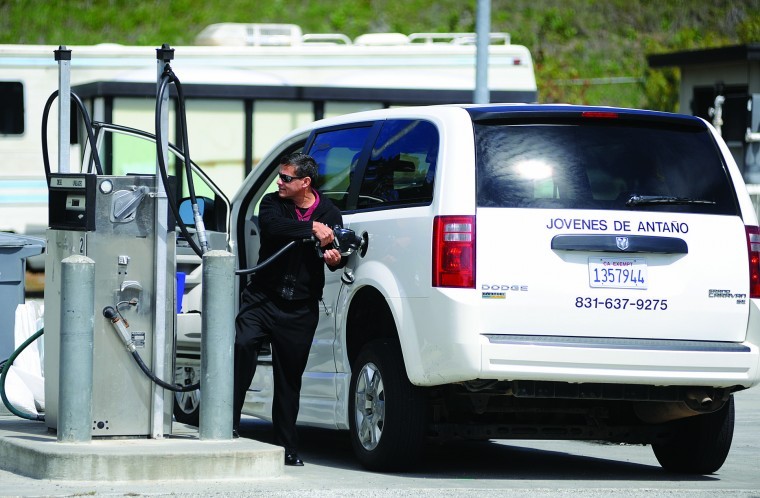It’s not just commuters who are feeling squeezed at the gas pump.
Rising fuel prices have forced local governments to stretch their gasoline budgets by limiting vehicle usage and redirecting money that would have been spent elsewhere – such as on road maintenance.
“We are impacted,” said San Benito County Public Works Administrator Steve Wittry. “The fund balances that support those efforts are suffering. Money that used to go toward materials is now being diverted toward fuel.”
Since the county’s budget includes line items for supplies and services, gas – which is a supply – is sometimes being paid for by spending less on services, such as toward rock material for road repairs.
“If we have to go put some asphalt on a pothole,” Wittry said, “we have to be more careful with material usage” because of the need to reserve budget money for fuel costs.
The county buys its fuel in bulk, receiving deliveries approximately once a month, so Wittry says officials get quotes from suppliers every time fuel is needed so they get the best price.
“We really haven’t changed our operations so much,” he said. “We’re just trying to conserve where we can.”
A bump in gas prices last year impacted the county’s budget, he noted, though “this year our budget was prepared for it a little bit more.”
Acknowledging the volatility of gas prices, the City of Hollister has made a concerted effort to reduce the amount of fuel it uses over the past few years, said City Manager Clint Quilter.
“You put more people in a vehicle – though sometimes that doesn’t work because we have fixed routes,” he said. “In general, we’re asking people to pay attention to what they’re using.”
City-owned vehicles in the 2009-10 fiscal year used 56,000 gallons of fuel and reduced that amount to 50,000 gallons in 2010-11.
“We’re on track to use somewhere between 50,000 and 51,000 this year,” Quilter said. “As gas prices have gone up we’ve tried to reduce that.”
Even with the reduction in fuel usage in recent years, city spending on fuel jumped 6 percent between 2009-10 and 2010-11.
“There will probably be a 15 to 20 percent increase in cost this year,” he said. “We try to get folks to cut back and will continue to do so. We’ve already reduced our services, so we’re not doing anything extraneous. We’re at the mercy of whatever those fuel prices are.”
The volatility of the fuel market is tempered by the city’s bulk purchases of fuel.
“It doesn’t fluctuate as much for us because we buy in bulk,” Quilter said. “It’s not like we run by the gas station every day.”
Hollister’s total fuel budget last year was $225,000 out of a nearly $30 million overall budget, while the general fund is closer to $14 million.
“It doesn’t mean that we’re not trying to save the money, but it hasn’t been something where it has caused us budgeting problems,” Quilter said, noting that each department has services and supplies budgets, allowing money to be shifted if costs in one line item rise.
“If somebody’s fuel budget goes up higher in a year, they’re expected to find other places in their budget to save that money,” he said.
City officials have the ability mid-year to take a fresh look at the spending plan.
“We can make adjustments, but we haven’t had to do that with fuel yet,” Quilter said.
Lisa Rheinheimer, executive director of the Council of San Benito County Governments, which oversees the county’s fixed-route bus service, said her agency does not yet have specific numbers regarding the budget impact of higher fuel prices, though she said “we are anticipating higher fuel prices for our transit operations.”
Of the approximately 30 vehicles operated under the auspices of the Local Transportation Authority, most of them use regular unleaded fuel, which has seen a price spikes in recent months.
“Until we know the full impact of higher prices, there’s not much we’re doing differently at this point,” Rheinheimer said. “When we get the numbers in May, we may as a staff look at our operations to see if there are some more opportunities there to save on fuel costs.”
In late 2008, local fixed-route bus service during the middle of the day – 11 a.m. to 2 p.m. – was reduced to save on fuel and other costs.
“As a general trend, though, when the cost of gas goes up we see ridership go up, so cutting back on services when people need it most is a challenge,” Rheinheimer said. “When gas costs more, we see more people switching over to our services because it’s cheaper oftentimes to ride County Express than to fuel up your own vehicle.”
When the price at the pump increases, local jurisdictions that benefit from gas taxes do not necessarily see more revenue, as those taxes are charged per gallon, not as a percentage of the price of that gallon. When gas prices rise and consumption drops, tax revenue drops as well.
“No matter whether the gas price is $5 per gallon or $2 per gallon, (cities and counties) get the same per gallon,” Rheinheimer said. “If it were a tax on the sale of the gas, not per gallon, then you’d see the increase in the amount of revenue.”










